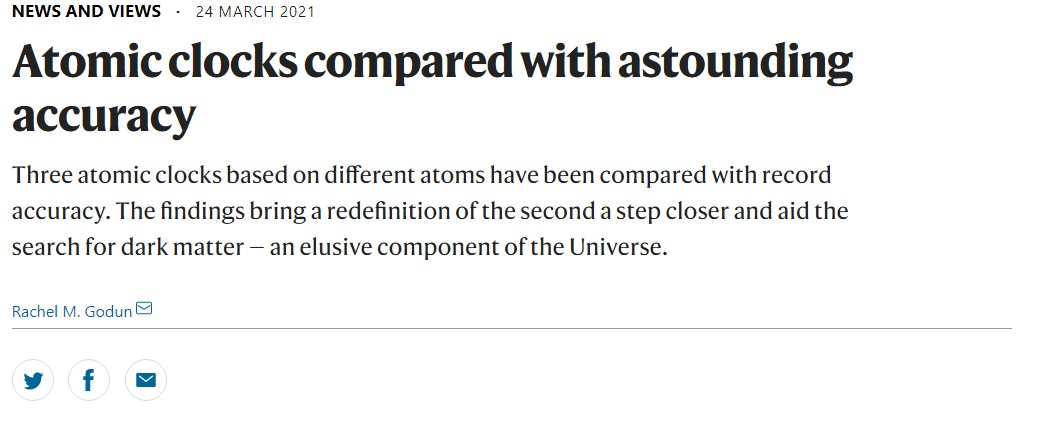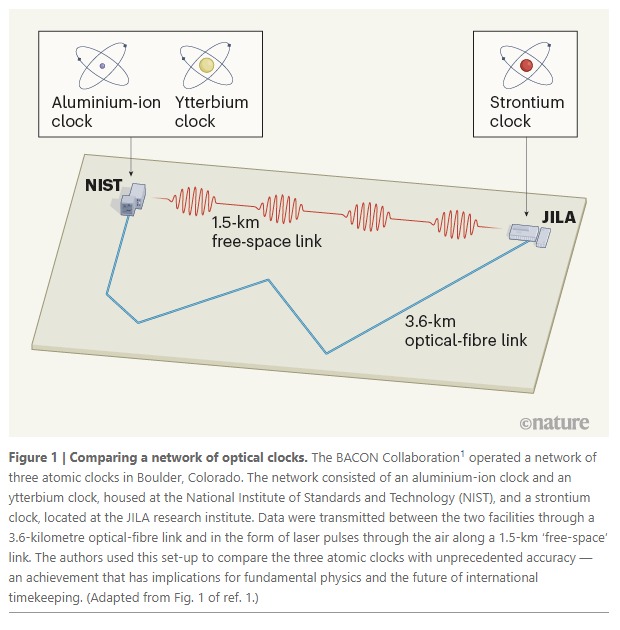물리News

The remarkable accuracy of atomic clocks makes them excellent instruments for timekeeping and other precision measurements. Writing in Nature, the Boulder Atomic Clock Optical Network (BACON) Collaboration reports extremely accurate comparisons of three world-leading clocks in Boulder, Colorado, housed at the National Institute of Standards and Technology (NIST) and the JILA research institute. The authors show how their clock comparisons provide insights into fundamental physics and represent substantial progress towards redefining the second in the International System of Units (SI).
Atomic clocks ‘tick’ at a rate determined by the frequency of light that is emitted or absorbed when an atom changes from one energy state to another. Clocks based on different atoms run at different rates, and the term ‘optical clock’ refers to one that runs at an optical frequency. Three of the world’s best optical clocks are the aluminium-ion and ytterbium clocks at NIST and the strontium clock at JILA. The measured frequencies of all three clocks are estimated to be correct to within a fractional uncertainty of 2 parts in 10 or better. This level of uncertainty could, in principle, allow the clocks to keep time so accurately that they would gain or lose no more than one second over the age of the Universe. Such optical clocks would be 100 times more accurate than caesium clocks.
There is therefore a desire to redefine the SI second in terms of an optical-clock frequency and to move away from the current definition based on caesium. But before such a redefinition is possible, scientists must build confidence in the reproducibility of optical clocks through a series of clock comparisons. The target accuracy for these comparisons is at the level of parts in 1018 to clearly demonstrate the superiority of optical clocks over caesium clocks.
Clock comparisons are carried out by measuring ratios of the optical-clock frequencies using instruments called femtosecond-frequency combs. Until now, the best comparisons between optical clocks based on different atoms have been at the level of parts in 1017. The BACON Collaboration presents measurements of optical-frequency ratios reaching uncertainties at the level of parts in 1018, bringing the redefinition of the SI second a step closer.
Such frequency-ratio measurements are no mean feat, and are equivalent to determining the distance from Earth to the Moon to within a few nanometres. Therefore, exceptional care is required to control any sources of frequency offset. The authors compared the aluminium-ion and ytterbium clocks at NIST and the strontium clock at JILA over several months to check reproducibility and reduce statistical uncertainties. They found that the day-to-day variation in the ratios was slightly larger than expected after accounting for all known effects. This observation suggests the existence of unknown effects, which are intrinsically hard to quantify. Nevertheless, the authors developed a statistical model to account for these uncertainties and to enable a rigorous assessment of the total measurement uncertainty.

The BACON Collaboration used redundant elements throughout the network of optical clocks to check for any sources of bias. In particular, the authors linked the clocks at NIST and JILA in two ways (Fig. 1). They used a 3.6-kilometre optical-fibre link — a tried-and-tested method for connecting signals between optical clocks at the required level of uncertainty. And, in what they believe to be a world first, they compared the clocks using a 1.5-km ‘free-space’ link by sending laser pulses through the air between NIST and JILA along a straight line joining the two institutes. They found that the two types of connection provided a similar level of uncertainty, apart from when data could not be obtained from the free-space link during a snowstorm.
The authors’ demonstration that high-accuracy clocks can be connected by free-space links, without needing an optical-fibre infrastructure, is exciting because it opens up possibilities for applications outside the laboratory, such as land surveying. According to Einstein’s theory of relativity, Earth’s gravity causes the frequency of an atomic clock to depend on its altitude. Consequently, the height difference between two remote clocks can be determined by measuring their difference in frequency. At the level of measurement uncertainty achieved in the latest work, clock comparisons could resolve centimetre-sized height differences. Therefore, clocks could provide new tools for long-term environmental monitoring of, for example, ice sheets or ocean levels.
The BACON Collaboration demonstrated another intriguing application of clock comparisons. The authors used the clock-frequency ratios to search for signs of possible interactions between atoms and dark matter — an elusive substance predicted to account for most of the matter in the Universe. According to current understanding, atoms do not interact with dark matter through electromagnetic forces. However, if these interactions were to exist, they would cause tiny changes in atomic-clock frequencies. The authors detected no such changes in their experiment, but a null result is still useful. Combined with previous data, the finding revealed that the maximum strength of any electromagnetic interactions between atoms and a particular type of dark matter was nearly ten times lower than previously determined.
Networks of optical clocks can also be used to explore many other aspects of physics, because their precision allows measurements of the world around us to be obtained at unprecedented resolution. Examples of such investigations include testing Einstein’s theory of relativity at ever more stringent levels, and searching for possible changes in the values of physical constants. Regardless of the application — whether in redefining the SI second, surveying or fundamental physics — the better the clock comparisons, the greater the impact. And with the current accuracy limits being set by technical issues, rather than fundamental limits, the prospects for even better measurements in the future are extremely promising.
Nature 591, 534-535 (2021)
doi: https://doi.org/10.1038/d41586-021-00738-0
출처 : https://www.nature.com/articles/d41586-021-00738-0
 이전글 이전글 |
[물리뉴스] 표준모형 깨지나_ 새로운 힘에 대한 가능성 발견2021-04-21 |
|---|---|
다음글  |
[물리뉴스] NISQ 시대의 양자 컴퓨터2021-04-26 |








